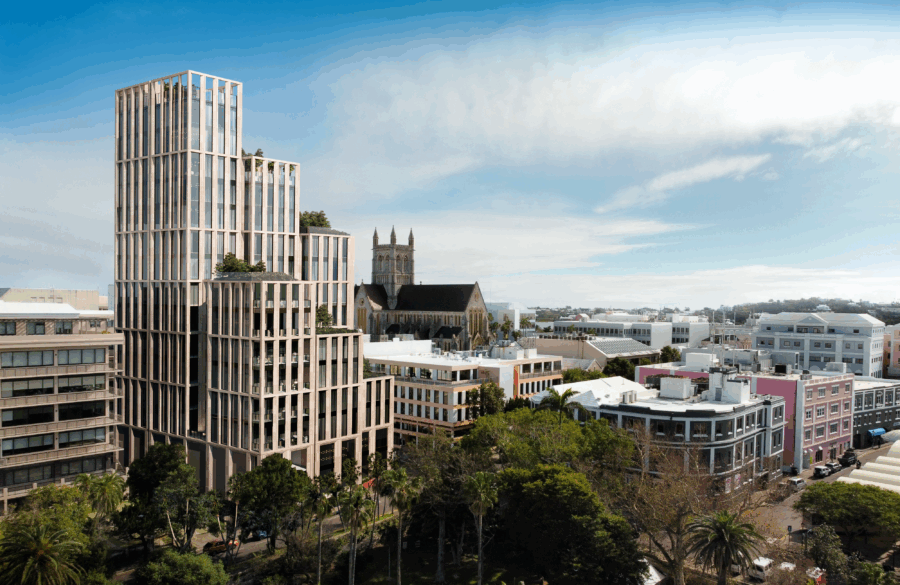Architects Jonathan Castro and Ché Caines have a dream.
It’s one where they can design and build state-of-the-art high-rise buildings exceeding the height of the Cathedral Of The Most Holy Trinity. There would be amenities such as parking, perhaps an indoor swimming pool, or rooftop infinity pool, and a roof terrace with panoramic views overlooking the entire island.
The E Se Studio architects even drew up a plan for how such a building might look, raising the question: Is it time to consign old restrictions to the history books?
This is not a question they pose lightly and, if it does happen, it needs to be done in collaboration with government, emergency services, construction companies, engineers and other affected and interested stakeholders. It also needs to be in particular areas of Hamilton. Not, for example, in the middle of Front Street.
“We can see an area in the North East Hamilton sector which will accommodate mixed used, commercial and residential buildings in the eight, 10 and even 20 storey height range,” Mr Caines said.
Aiming for a balance
He explained that “by isolating this kind of development in certain parts of the city, it protects the image of Front Street and the historical context of the city”.
“The challenge would be in making sure not to pull away the buzz from this part of the city to another area, but creating an equal balance,” he said.
“There will need to be regulations to maintain the small businesses in the area and also promote developments that cater to locals, the community and tourism.”
Incentivised building heights, where developers gain more by giving back to the community, is a model they think would work well for Bermuda.
“If a developer, especially a foreign developer, comes to develop, say, luxury high-end mixed-use office, retail and residences, their incentive might be that the government would allow them less tax or more floors to develop, if they give back a park to the community that they’re building around. Or a nursery, or playground, or affordable housing.”
This is common practice in cities such as London.
The long-term outcome of this, they said, would be growth, jobs, a boost for the construction sector, inner city homes, and walkable communities, which are less car dependent because everything they need, such as grocery stores, schools, public transport, parks, is on their doorstep.
 Cake-tiered approach
Cake-tiered approach
To prevent significant overshadowing, Mr Caines believes the “cake-tiered” approach to building design would work well: “It makes sense to have some type of code surrounding certain setbacks and how the massing is designed and developed on the site,” he said.
While some shadow would be inevitable, this isn’t necessarily a bad thing, especially in the hotter months.
“In some cases, this reduces street level heat in the summer time and, again, the building mass plays a role here. Introducing shading elements and deep overhangs can reduce internal heat gain which, in turn, reduces the building’s energy consumption to keep the interiors cool.”
Mr Castro said: “Light, wind, how the building sits within the site is important to navigate.”
He wants to see “another level of thinking” away from the setback designs on Front Street.
“Give designers and developers freedom to shape these buildings, but in an intelligent way, so not everything looks the same,” he said.
‘We have to go up’
To demonstrate the vision, a theoretical 16-storey building Mr Caines designed for 39 Cedar Avenue comprises rectangles of different heights, each with their own roof garden. This also proved that when a building of this height starts at a lower level than the Cathedral, and is some distance away, it doesn’t necessarily stand out as significantly taller.
Ironically, he explained, these larger buildings have a smaller footprint.
“When you do a lower level building, you’re going to take up a higher percentage of that footprint, whereas if you’re doing a higher building, which is common in larger cities, you don’t need a massive site to be able to accommodate a large amount of units.”
Mr Castro added: “The reality is, we only have a certain amount of landmass. That landmass is getting eaten up every day by homes people want to build.
“Eventually it’s going to come that we have to go up. Looking at our neighbours across the water, everyone’s going up. Everyone’s trying these systems out. It’s been tested elsewhere and it’s becoming very successful.”
If, or when, these buildings are built in Bermuda, Mr Caines wants to avoid the “conventional Bermudian construction methodology of concrete block walls”, which is laborious and expensive.
Instead, drawing on his experience designing large buildings in the Middle East, Asia and Europe, he would like to use “hung façade systems, specifically GFRC panels, which are a high-performance concrete system fortified with multiple layers of resilient glass fibres.”
Mixed feedback
The benefits of this include design flexibility, offshore manufacturing, speed and reduced manpower.
In addition, a building of this scale would usually consist of a reinforced concrete core, which houses the elevator voids, stairs and HVAC risers that service the building’s main lines, such as fire suppression systems, electrical and plumbing.
“Outside of this core is commonly a steel frame construction with a reinforced decked floor,” he continued.
An example of this is the Brookfield building currently under construction on Front Street.
Feedback to their proposals has been mixed but they are determined this is the only way forward, as long as it is done well and collaboratively.
“The younger generation seems to look more towards change, and then the older generation seems to be more on board keeping that quintessential Bermuda look, which is fine, and it is very important to maintain that and acknowledge that that’s an identity that we formed and it’s been formed throughout generations,” Mr Caines said.
“But I also believe that the only way in which we can move forward, as a country, and have our city expand without the space that we are limited to, is by going up and doing this intelligently.”

